
Spring is finally forcing its way into Michigan allowing NRCS staff to get back in the field and for hands-on outdoor training to resume. Our field offices are also fully open with walk-ins now welcome and facemasks no longer required for visitors and staff in counties with low or medium risk of transmission. NRCS will remain vigilant to minimize the risk of Covid transmission to our staff and customers and will adjust our practices and procedures accordingly based on Center for Disease Control and local guidance.
Already this spring our NRCS-Michigan wetland compliance team held a training to improve our process for processing preliminary wetland conservation and highly erodible land determinations and appeals. Michigan has one of the highest workloads in the country for WC/HEL determinations and we have been continually improving our processes and reducing our backlog of WC/HEL reconsiderations. Spring weather also allowed NRCS staff to participate in a prescribed burning training at the Rose Lake Plant Materials Center near East Lansing. The training allowed NRCS staff to observe and participate in prescribed burns at the center. Finally, NRCS engineering staff held an in-person training conference in Sault Ste. Marie in April. These in person training events and meetings are especially important for our new staff members who have worked mostly virtually since starting with NRCS.
~
There continues to be great demand for conservation assistance from Michigan producers. NRCS-Michigan was able to allocate all of our general Environmental Quality Incentives Program funding after our first application selection period. Michigan received EQIP applications requesting more than 2.5 times the amount of funding available.
Happy Spring everyone!
(top photo) NRCS-Michigan HEL/WC compliance team training. (bottom) NRCS-Michigan engineering staff go on a tour of the Soo Locks during their training event in Sault Ste. Marie.
|
 
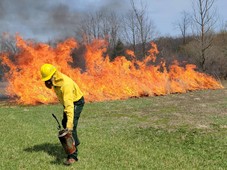
Prescribed burning is a valuable tool for maintaining and improving native grass and pollinator plantings and is eligible for financial assistance through NRCS programs. In April a prescribed burning course was held for NRCS staff at the Rose Lake Plant Materials Center, the two-day course included demonstration burns of three plots.
About 25 employees enrolled for the course, said NRCS State Biologist Barbara Scott. The purpose of the course was to train field staff to be able to write or review burn plans for landowners. Prescribed burns are an effective method of controlling invasive weeds and woody growth in native grass and wildflower plantings.
Observing the prescribed burns was the highlight of the training for Soil Conservationist Ashli Holloway. “I enjoyed it immensely.” Holloway has never assisted a landowner with planning a prescribed burn but says she would be more comfortable doing so after the training. Burning could be more effective than brush management practices she has contracted for landowners in the past, said Holloway.
The burns conducted at the training included plots of different sizes and plant species to give students an idea of how quickly and intensely they can burn. The course was conducted by Scott along with State Forester Andy Henriksen, Rose Lake PMC Manager Chris Sheahan, and State Resource Conservationist Dan Zay.
|
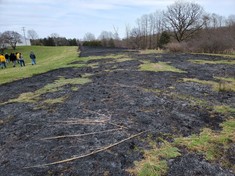 |
|
(above left) State Resource Conservationist Dan Zay helps conduct a prescribed burn at the Rose Lake Plant Materials Center as part of a training course for NRCS staff. (left) One of the plots after the burn was completed. |
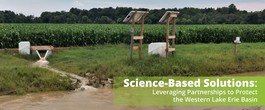
A new USDA video provides a closer look at the collaborative partnerships driving innovative water quality assessment and conservation in the Western Lake Erie Basin. The video, Science-Based Solutions: Leveraging Partnerships to Protect the Western Lake Erie Basin, shows how USDA’s Conservation Effects Assessment Project (CEAP) watershed studies in the Western Lake Erie Basin bring researchers, farmers, government agencies and nonprofit organizations together to develop science-based solutions and strategically place them where they can deliver the greatest conservation benefits.
Under CEAP, a network of researchers, from government agencies to universities, work together to monitor the impact of conservation practices on the landscape. These studies directly inform USDA’s Natural Resources Conservation Service programs, practices and planning and ensure that the agency provides technical and financial assistance to landowners to develop and implement impactful conservation plans.
Regional partnerships like those driving conservation efforts in the Western Lake Erie Basin have proven to be effective, as demonstrated by the recently released USDA report, Conservation Practices on Cultivated Cropland: A Comparison of CEAP I and CEAP II Survey Data and Modeling.
CEAP is a multi-agency effort to quantify the environmental effects of conservation practices and programs and develop the science base for managing the agricultural landscape for environmental quality. Project findings will be used to guide USDA conservation policy and program development and help conservationists, farmers and ranchers make more informed conservation decisions.
|
By Jonathan Díaz Cruz (Soil Scientist) and Greg Schmidt (Ecologist) — Grand Rapids, Michigan
The Grand Rapids and Flint, Michigan Soil Survey Office upgraded two more Mucky Depressions Ecological Site Descriptions (ESDs) from provisional to approved status in FY 2021. This brings the total number of approved Mucky Depressions ESDs in southern Lower Michigan to three. While basic information and the structure of the state-and-transition model remain unchanged from provisional status, a complete narrative of ecological dynamics and a thorough species checklist for many of the community phases are included in the approved ESD. The upgraded ESD will help conservation planners determine community status and assess the long-term success of wetland restorations.
Building on prior mucky fieldwork in MLRAs 97 and 98, soil scientist Jonathan Diaz-Cruz and ecological site specialist Greg Schmidt spent two field days collecting data on the yet-to-be-documented mucks in MLRA 99–Erie-Huron Lake Plain.
Three sites were fully described with vegetation plots and soils descriptions. The first site was in a dense shrubby thicket described as the Napoleon series (Dysic, mesic Typic Haplohemists) and thereby more consistent with Acidic Peaty Depression than Mucky Depression. Vegetation was dominated with chokeberry (Aronia), highbush blueberry (Vaccinium corymbosum), and with minor amounts of leatherleaf (Chamaedaphne) on hummocks of peat moss (Sphagnum), as one might find in a peat bog. The second and third sites had higher pHs and were thus true Mucky Depression. They were located in forested conditions with soils described as an Edwards taxadjunct (Marly, euic, mesic Limnic Haplohemists), supporting a northern white cedar swamp, and a silver maple forest on soils described as the Palms series (Loamy, mixed, euic, mesic Terric Haplosaprists). Mucky Depressions is not widespread in MLRA 99. It has been subject to agricultural conversion in many areas; therefore, not all possible community phases were available for sampling.
MLRA staff used work previously conducted within MLRAs 97 and 98 to help fully characterize the MLRA 99 Mucky Depressions community phases. Based on cluster analysis, the cedar swamp plot clustered with the plots used to characterize the red maple-tamarack reference phase in the MLRA 98 version of Mucky Depression. The silver maple swamp clustered with the hardwood swamp phase. Cluster analysis using the Bray-Curtis dissimilarity index for species composition performed better than other common dissimilarity indices (e.g., Jaccard, Kulczynski, Simpson). Log-transformed species abundance was preferred over square-root transformation, untransformed data, and presence and absence data. Previously, the staff used Ward clustering as the optimal linkage method over other linkage methods (e.g., UPGMA, Diana, Complete-linkage). However, this year, staff used the Flexible-beta method, which had a similar dendrogram structure as the Ward method, but with better Silhouette index and OptimClass indicator species-based performance measures.
Ecological site keys are organized by MLRA, but due to recent aggregation of map units, the same component might span several MLRAs. Consequently, some soil components may be populated with more than one ecological site. Similar soils in an adjacent MLRA can have virtually the same ecological site. In these cases, misidentifying MLRA ecological site legend would have little consequence to management interpretations. But for MLRAs separated by climatic factors, species composition and disturbance regimes tend to differ among ecological sites mapped to the same soil component. Correct site identification is therefore consequential to management interpretations in this later case. If this were only the case of map units “feathering” into the adjacent MLRA, consistent with the fuzzy boundary of MLRA concepts, the relative proximity to the boundary would likely also be reflected by an equally fuzzy transitional vegetation. However, trans-MRLA map units can manifest as islands far from MLRA boundaries. The adjacent intra-MLRA map units may have more management interpretations in common than the same map unit mapped elsewhere.
The initial strategy employed in the Northeast Soil Survey Region for correlating provisional ecological sites to components was to use Geographic Information System to determine the dominant distribution (MLRA affinity) of each map unit and assign components with a single ecological site from the appropriate MLRA ecological site legend. But some map units lacked a dominant MLRA affinity, making the assignment of only a single ecological site untenable.
EDIT, the agency’s platform for serving ecological information, does not have a mechanism for accommodating ecological site concepts that span MLRA boundaries—and site keys do not provide links to adjacent MLRA to identify legitimate outliers that are geographically embedded.
To ensure that only species appropriate to the MLRA are used in planning, MLRA staff plan to disaggregate all Mucky Depression map units overlapping the Grand Rapids Soil Survey Office management area in a future project.
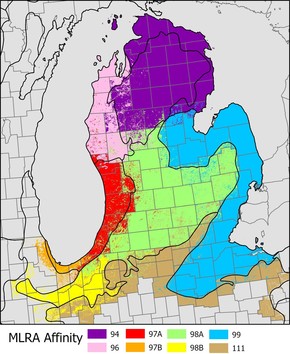
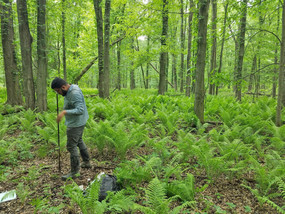
(left) Soil Scientist Jonathan Diaz-Cruz digging at the third site, dominated by Ostrich ferns.
(below left) Representation of the Edwards taxadjunct at the second site. From top left to bottom right we see sapric, hemic & marly materials of this organic soil profile.
|
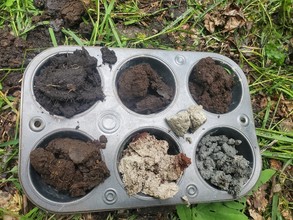

Justine Reid - EQIP Coordinator, East Lansing
Last Position: District Conservationist, Rapid City, S.D.
Hometown: Bad Axe
Education: B.S. in Animal & Dairy Science, B.S. in Wildlife & Fisheries Sciences – Eastern New Mexico University; Graduate Certificate in Grasslands Management – University of Nebraska
Family: Husband Jeremy; daughter Annabelle; sons Hudson, Paxton, and Yukon; cats Spot and Duchess, rat dog Lucky
Hobbies & Interests: Anything touristy, hunting, fishing, camping, sports and scouts with my kids
|

Lane Ross - Soil Conservationist, Grand Rapids
Last Position: Student
Hometown: Woodville, Miss.
Education: Associates of Arts, Bachelor of Science Plant and Soil Sciences - Alcorn State University
Hobbies & Interests: Fishing, Hunting, and Sports
|
Employee Updates
Josh Crandall - District Conservationist Jonesville, formerly DC Centerville

May
11 - MSU Hop Chat Series, noon, bi-weekly series via Zoom, first session is May 11 continuing through Aug. 2, for more information and to register go to www.canr.msu.edu/events
11 - MSU Chestnut Chat, 1:30 to 2:30 p.m., bi-weekly series via Zoom, first session is May 11 continuing through Aug. 31, for more information and to register go to www.canr.msu.edu/events
12 - Field Crops Virtual Breakfast, 7 to 8 a.m., weekly sessions via Zoom, for more information including weekly topics go to www.canr.msu.edu
12 - Evenings in the Garden Spring 2022: Attracting Wildlife with Backyard Water Features, 6:30 p.m. to 8:30 p.m., 28115 Meadowbrook Rd., Novi, for more information go to www.canr.msu.edu/events
14 - 2022 MSU Tollgate Farm Homegrown Gardening Series: Bringing Eden to our Communities with Edible Forests, 10 a.m. to 11 a.m., Zoom and Hybrid, for more information go to www.canr.msu.edu/events
18 - Smart Gardening at Windmill Island Gardens, 6:30 p.m. to 7:30 p.m., Windmill Island Gardens Pavilion, Holland, for more information go to www.canr.msu.edu/events
June
2 - Forestry Consultation Workshop for Forest Owners, 6 p.m. to 7:30 p.m., Motz Park Pavilion - St. Johns, for more information go to clintonconservation.org
6&7 - MACD Summer Conference, Double Tree Inn - Bay City, for more information go to macd.memberclicks.net
18 - Pollineighbor Celebration, 11 a.m. to 4 p.m., 28115 Meadowbrook Rd. Novi, for more information go to www.canr.msu.edu/events
20-23 - 2022 North Central Regional Cooperative Soil Survey Conference, Grand Valley State University Eberhard Center - Grand Rapids, for more information and to register go to events.anr.msu.edu
25 - Public Tour of MSU Student Organic Farm, 1 to 2 p.m., MSU Student Organic Farm - 3291 College Rd., Holt, for more information go to www.canr.msu.edu/events
|
|